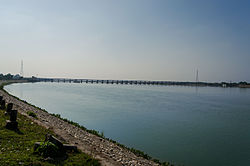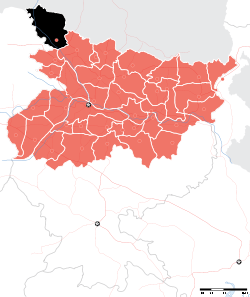West Champaran district
West Champaran is an administrative district in the state of Bihar in India, located just 60 km (37 mi) west of Birgunj. It is a part of Tirhut Division[1] (Tirhut). The district headquarters are located in Bettiah. The district is known for its fluid border with Nepal. One of the major location in West Champaran is KumarBagh and Vrindavan belongs to KumarBagh where Mahatma Gandhi started Satyagrah Aandolan.
West Champaran district | |
|---|---|
District of Bihar | |
 | |
 Location of West Champaran district in Bihar | |
| Country | India |
| State | Bihar |
| Division | Tirhut |
| Headquarters | Bettiah |
| Tehsils | 18 |
| Government | |
| • Lok Sabha constituencies | Bettiah, Valmiki Nagar |
| • Vidhan Sabha constituencies | Valmiki Nagar, Ramnagar, Narkatiaganj, Bagaha, Lauriya, Nautan, Chanpatia, Bettiah, Sikta |
| Area | |
| • Total | 5,228 km2 (2,019 sq mi) |
| Population (2011) | |
| • Total | 3,935,042 |
| • Density | 750/km2 (1,900/sq mi) |
| Demographics | |
| • Literacy | 58.06 per cent |
| • Sex ratio | 906 |
| Time zone | UTC+05:30 (IST) |
| Major highways | NH 28B |
| Website | http://westchamparan.bih.nic.in/ |
Geography
West Champaran district occupies an area of 5,228 square kilometres (2,019 sq mi),[2] comparatively equivalent to Canada's Amund Ringnes Island.[3]
Flora and fauna
In 1989 West Champaran district became home to Valmiki National Park, which has an area of 336 km2 (129.7 sq mi). It is also home to two wildlife sanctuaries: Valmiki (adjacent to its namesake national park) and Udaypur Wildlife Sanctuary.[4] Fauna include the Bengal tiger.[5][6]
Sub-Divisions
West Champaran district comprises the following Sub-Divisions: Bettiah, Bagaha, and Narkatiaganj.
Blocks: Bettiah, Sikta, Mainatand, Chanpattia, Bairia, Lauria, Bagaha - 1, Bagaha - 2, Madhubani, Gaunaha, Narkatiaganj, Manjhaulia, Nautan, Jogapatti, Ramnagar, Thakraha, Bhitaha, Piprasi
Demographics
| Year | Pop. | ±% p.a. |
|---|---|---|
| 1901 | 762,628 | — |
| 1911 | 812,855 | +0.64% |
| 1921 | 826,679 | +0.17% |
| 1931 | 913,931 | +1.01% |
| 1941 | 1,021,217 | +1.12% |
| 1951 | 1,071,382 | +0.48% |
| 1961 | 1,325,122 | +2.15% |
| 1971 | 1,587,019 | +1.82% |
| 1981 | 1,972,610 | +2.20% |
| 1991 | 2,333,666 | +1.70% |
| 2001 | 3,043,466 | +2.69% |
| 2011 | 3,935,042 | +2.60% |
| source:[7] | ||
According to the 2011 census West Champaran district has a population of 3,935,042,[9] roughly equal to the nation of Liberia[10] or the US state of Oregon.[11] This gives it a ranking of 63rd in India (out of a total of 640).[9] The district has a population density of 950 inhabitants per square kilometre (2,500/sq mi) .[9] Its population growth rate over the decade 2001-2011 was 28.89%.[9] Pashchim Champaran has a sex ratio of 906 females for every 1000 males,[9] and a literacy rate of 58.06%.[9]
Connectivity
The district is well connected by roads and railways to all major cities.
Languages
At the time of the 2011 Census of India, 95.23% of the population in the district spoke Hindi, 2.97% Urdu, 0.99% Bengali and 0.66% Kurukh as their first language.[12]
Languages include Bhojpuri, a tongue in the Bihari language group with almost 40 000 000 speakers, written in both the Devanagari and Kaithi scripts.[13]
Culture
The city is the birthplace of poet Gopal Singh Nepali. Mahatma Gandhi started the Champaran Satyagraha movement from here in 1917 along with nationalists Rajendra Prasad, Anugrah Narayan Sinha and Brajkishore Prasad.
Notable people
- Manoj Bajpayee, Film actor.
- Dinesh Bhramar, Poet & Writer
- Vinay Bihari, Actor, Lyricist.
- Mahatma Gandhi, freedom fighter who started the Champaran Satyagraha movement here.
- Sanjay Jaiswal, Politician
- Prakash Jha, Film director.
- Baidyanath Prasad Mahto, Politician, Member of Parliament.
- Krishna Kumar Mishra, Politician.
- Gopal Singh Nepali, Hindi poet.
- Gauri Shankar Pandey, Politician.
- Kedar Pandey, Politician
- Raghaw Sharan Pandey, IAS (Retd), Former Union Petroleum Secretary, Politician
- Damodar Raao, Film Music Director, Actor & Singer
- Valmiki Rishi, an ascetic who wrote Hindu epic Ramayana here.
See also
References
- http://tirhut-muzaffarpur.bih.nic.in Archived 2015-03-16 at the Wayback Machine
- Srivastava, Dayawanti et al. (ed.) (2010). "States and Union Territories: Bihar: Government". India 2010: A Reference Annual (54th ed.). New Delhi, India: Additional Director General, Publications Division, Ministry of Information and Broadcasting (India), Government of India. pp. 1118–1119. ISBN 978-81-230-1617-7.CS1 maint: extra text: authors list (link)
- "Island Directory Tables: Islands by Land Area". United Nations Environment Program. 1998-02-18. Archived from the original on 2015-12-01. Retrieved 2011-10-11.
Amund Ringnes Island 5,255km2
- Indian Ministry of Forests and Environment. "Protected areas: Bihar". Archived from the original on August 23, 2011. Retrieved September 25, 2011.
- Jhala, Y. V.; Gopal, R.; Qureshi, Q., eds. (2008), Status of the Tigers, Co-predators, and Prey in India (PDF), TR 08/001, National Tiger Conservation Authority, Govt. of India, New Delhi; Wildlife Institute of India, Dehradun, archived from the original (PDF) on 2 June 2013
- Jhala, Y. V., Qureshi, Q., Sinha, P. R. (Eds.) (2011). Status of tigers, co-predators and prey in India, 2010. National Tiger Conservation Authority, Govt. of India, New Delhi, and Wildlife Institute of India, Dehradun. TR 2011/003 pp-302
- Decadal Variation In Population Since 1901
- "Pashchim Champaran Religion-wise Data 2011". Census 2011. Archived from the original on 13 March 2018. Retrieved 13 March 2018.
- "District Census 2011". Census2011.co.in. 2011. Archived from the original on 2011-06-11. Retrieved 2011-09-30.
- US Directorate of Intelligence. "Country Comparison:Population". Archived from the original on 27 September 2011. Retrieved 2011-10-01.
Liberia 3,786,764 July 2011 est.
- "2010 Resident Population Data". U. S. Census Bureau. Archived from the original on 2013-10-19. Retrieved 2011-09-30.
Oregon 3,831,074
- 2011 Census of India, Population By Mother Tongue
- M. Paul Lewis, ed. (2009). "Bhojpuri: A language of India". Ethnologue: Languages of the World (16th ed.). Dallas, Texas: SIL International. Archived from the original on 2011-10-06. Retrieved 2011-09-30.